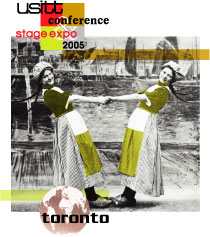 |
 |
 |
|
July 2004
News & Notices
News From:
Commissions
Conference &
Stage Expo
Stage Expo
For the Record
 |
||
| |
||
|
This past Christmas, my daughter presented me with a copy of Kevin Bazzana’s Wondrous Strange: The Life and Art of Glenn Gould. The brilliant and eccentric pianist was born in Toronto, spent as much of his life here as possible, and died here in 1982 at the age of 50. Mr. Bazzana raises the interesting thesis that Mr. Gould’s early years in the parochial, Anglophilic, Protestant Toronto of the 1930s and 1940s did not stultify Gould’s genius but, paradoxically, nurtured it. Reading the account of this musician’s childhood, I was struck by the astonishing difference between the city of his youth, and the city in which my daughter was raised 50 years later. Before World War II, Toronto’s population was predominantly British in origin, Protestant, socially repressive, and, frankly, xenophobic. Torontonians generally ate terribly bland and over-cooked food at home, and occasionally went to restaurants where the food was, reputedly, even worse. Half a century later my daughter – of northern European stock – grew up as a member of an ethnic minority; one of the hundred minorities that comprise the population in a city in which less than half the population claims English as its mother tongue. After World War II, the Canadian government decided that the country would benefit by actively encouraging immigration, and no government since has reversed that policy. The ethnic make-up of the country started to change slowly in the 1950s. Since one-third of immigrants to Canada typically settle in Toronto, the rate of change was accelerated here. First came large numbers of Europeans – particularly from Italy, Portugal, Greece, Poland, and Hungary. The tantalizing aromas of real coffee and edible food wafted onto the sidewalks of the city that the rest of the country referred to as “Hogtown.” The next major change occurred when, in the 1960s, the government dropped its stated preference for European immigrants. In 1971, the country officially adopted the policy of Multiculturalism, which gives residents the option to define the degree of cultural affinity they wish to maintain, and does not promote the melting pot model of assimilation. Between 1971 and 1996 the population of the Greater Toronto Area grew by 61 percent, and the proportion of residents claiming origin from Asia, Africa, and the Caribbean grew from four percent to 26 percent - and it is higher today. Approximately 38 percent of Torontonians are actually foreign born, and approximately half would be considered visible minorities. Today, Toronto is considered to be one of the most ethnically and culturally diverse cities in the world. So, how does it work? While groups of immigrants will often initially settle in the same area, these are not exclusive enclaves. Most neighbourhoods are decidedly mixed; their inhabitants determined more by economics than race or language. We do constantly face the challenge of making our institutions reflect the diversity of our population. This is quite an issue for the police service – and for our professional theatre, both onstage and backstage. In general, however, Toronto’s constantly evolving multicultural experiment works fairly well, is constantly studied by various scholars and institutions, and has been generally embraced. The cultural vitality of Toronto can be seen and heard throughout the entire city. There are many festivals and parades throughout the year. Take a ride on the subway, and hear how many of the city’s 100 languages you can identify. Best of all, Toronto’s cultures are represented by an extraordinary range of restaurants. While the different cuisines are liberally interspersed in restaurants all over town, there are many areas – complete with bilingual street signs – that feature the shops and restaurants of a particular ethnic group. There are Italian, Greek, Portuguese, Indian, and Korean areas within a few subway or streetcar stops, and the oldest of six Chinatowns is within walking distance of your hotel. When you book your trip to Toronto for the USITT Annual Conference & Stage Expo next March, plan to give yourself some time to walk out of your hotel and visit the rest of the world.
|
Toronto
Offers Diverse Cultures |
|
